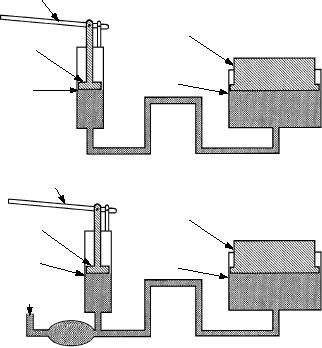
CHAPTER 9
PNEUMATICS
INTRODUCTION
NOTE: Fluid Power, NAVEDTRA 14105,
contains a detailed discussion of the fundamentals of
As an Aviation Support Equipment Technician,
hydraulics and pneumatics and the operation of the
you will be responsible for maintaining compressed
various types of components found in fluid power
nitrogen and air handling equipment. To do so, you
systems. You should supplement this text by reading
must be able to operate the equipment as well as
pertinent sections of Fluid Power.
perform preventive and corrective maintenance on it.
Q9-1. What is the major difference between gases
You will need to have knowledge of the properties of
and liquids?
compressed nitrogen and air, storage devices, and
1. Liquids have no definite shape
equipment for delivering the gases to users, as well as
2. Liquids conform to the shape of their
safety procedures for protecting you and the
container
equipment.
3. Gases are highly compressible
PNEUMATIC SYSTEMS
4. Gases transmit force in a completely
different manner
LEARNING OBJECTIVE: Identify the
principles of pneumatic systems.
NITROGEN
Pneumatics is the branch of fluid power that
LEARNING OBJECTIVE: Identify the
pertains to gaseous pressure and flow. Pneumatics
types and characteristics of gaseous nitrogen.
d i ff e r s f r o m hy d r a u l i c s i n t h a t ga s e s ( u s u a l l y
compressed air or nitrogen) rather than liquids are used
To effectively service and maintain nitrogen and
to transmit forces.
other compressed gaseous servicing equipment, you
must be familiar with the components and operating
The characteristics of a confined gas are very
procedures of the equipment. This text covers some of
similar to those of a confined liquid. Like liquid, a gas
has no definite shape, but conforms to the shape of its
HANDLE
container. Pascal's law applies to gases because gases
transmit force in much the same way that liquids do.
PISTON
(2)
PISTON
(1)
U n l i ke l i q u i d s , h ow eve r, g a s e s a r e h i g h l y
CYLINDER
compressible. This characteristic is the major
CYLINDER
(2)
(1)
difference between the two, and is the reason that gases
provide a much less rigid force than liquids. For
example, compare the hydraulic system shown in
figure 9-1, view A, to an almost identical pneumatic
VIEW A: LIQUID
system shown in view B. It would require the same
amount of force on piston (1) of either system to
HANDLE
overcome equal resistant forces acting against piston
PISTON
PISTON
(2)
(2). However, because of its compressibility, a gas
(1)
decreases in volume as it increases in pressure.
CYLINDER
CYLINDER
(1)
Therefore, in the gaseous system, a large portion of the
(2)
travel of piston (1) is used to compress the gas. For this
FROM AIR
reason, gases for pneumatic systems, such as shown in
figure 9-1, view B, are compressed in advance and
stored in attached containers. Gas is then released from
VIEW B: GAS
the container in sufficient volume and at the correct
ASf09001
Figure 9-1.--Transmission of force by liquids and gases.
pressure to accomplish the required work.
9-1

